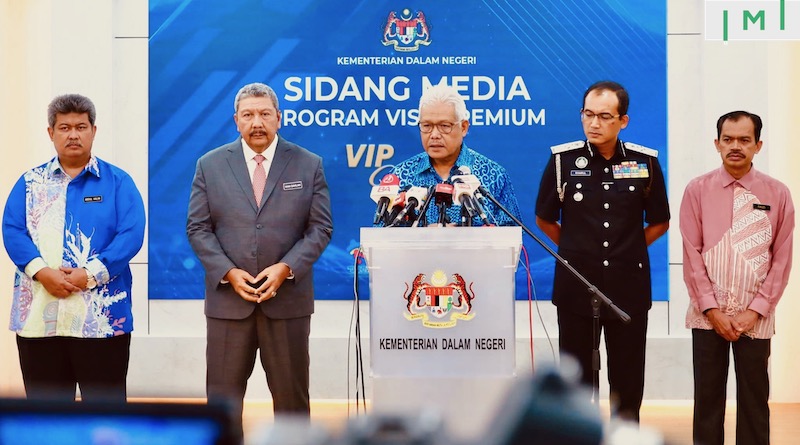Malaysia’s Surprise Introduction of “Premium Visa Program” for “Tycoons” Raises Eyebrows
In a press conference yesterday, Malaysian Home Minister Datuk Seri Hamzah Zainudin announced the introduction of a new “residence by investment” visa – officially named the Premium Visa Program (PViP) – aimed at attracting thousands of “global tycoons” starting October 1st, when it opens for applications.
The program means to grant access to Malaysia for 20 years with visas of five-year validities issued at five-year intervals for a maximum of four times (Malaysian law does not permit the issuance of visas with validities of more than five years.)
The total number of participants (including dependents) in the PViP and MM2H combined is capped at 1% of the total number of Malaysians, which comes to about 300,000 participants.
Hamzah says his Ministry aims to sign up as many as 1,000 foreigners in the first year alone.
The program’s core requirements are similar to those of the MM2H:
- Applicants must deposit MYR 1 million (about US$223,000) in an account at a Malaysian bank and may withdraw as much as half of this after a year for the purposes of buying real estate or to pay for educational or medical expenses.
- Applicants must have an offshore income in excess of MYR 480,000 (about US$107,000) annually.
- Applicants may include dependents – children (up to 21 years old), spouses, parents, parents-in-law, and even domestic workers – in their application.
- Applicants must have valid health insurance, though initial reports did not specify what level of expenditure must be covered.
- The program is open to applicants from all countries, except those with which Malaysia does not maintain diplomatic relations (such as Israel).
- Applicants and dependents must submit a Letter of Good Conduct from their home country’s government.
Despite the two program’s many similarities, the Minister emphasized that the PViP will not replace the MM2H, which he said focused on retirees, rather than active participants in the Malaysian economy.
“We are also confident that the [PViP] can draw more foreign direct investment that can strengthen the economy and create jobs for Malaysians. Demand for the ringgit will also increase and its value will also strengthen,” said the Home Minister yesterday.
Indeed, the new program differs from the MM2H in certain crucial respects:
How is the Premium Visa Program different from the Malaysia My 2nd Home (MM2H) Program?
- The PViP is open to applicants of all ages, while MM2H has a minimum age of 35.
- Participants in PViP will be permitted to study, invest (in approved sectors), run businesses, and take up employment, whereas MM2H participants are merely allowed to reside in Malaysia.
- The processing fee for PViP is MYR 200,000 for the main applicant and MYR 100,000 per dependent, while for MM2H the corresponding fees are a much lower MYR 5,000 and MYR 2,500, respectively.
- Whereas MM2H applicants must demonstrate a minimum liquid net worth of MYR 1.5 million, no such requirement appears to apply to PViP participants.
- Whereas MM2H participants must spend 90 days per year in the country, it appears no such day count requirement applies to PViP participants.
Neither program offers a path to permanent residence or citizenship.
| MM2H | PViP | |
|---|---|---|
| Applicant minimum age | 35 | N/A |
| Physical presence requirement | 90 days a year | N/A |
| Processing fees | MYR 5,000 for the main applicant and MYR 2,500 per dependent | MYR 200,000 for the main applicant and MYR 100,000 per dependent |
| Minimum liquid net worth proof | MYR 1.5 million | N/A |
| Work and study permitted? | No | Yes |
Why would someone choose to participate in the Premium Visa Program rather than in the MM2H?
Many commenters in the media have questioned why anyone would participate in the new program when the MM2H offers many of the same benefits without charging exorbitant processing fees.
In a nutshell, the PViP is costlier than the MM2H, but also less restrictive.
While the bank deposit requirements are the same for both schemes, PViP requires far higher application fees. For a family of four (husband, wife, and two children), for example, application fees would amount to MYR 12,500 (some US$2,800) under MM2H but to a remarkable MYR 500,000 (US$112,000) under PViP.
On the other hand, the PViP has no minimum liquid asset requirement, no minimum day-count, no age limit, and also allows the applicant to work, study, invest, and run a business in Malaysia.
The circumstances under which an applicant may find it advisable to incur the additional cost of participating in the PViP rather than the MM2H are those where the applicant either
a) wishes to work or study in Malaysia;
b) wishes to avoid the 90-day physical presence requirement;
c) is too young to participate in MM2H; and/or
d) cannot meet the MYR 1.5m minimum liquid assets requirement (but can somehow still afford the higher processing fees).
Whether thousands of people fit that bill remains to be seen, particularly in light of the capriciousness with which the Malaysian government treated its MM2H visa holders during the pandemic when thousands of them were not permitted to enter the country (and return to what they considered their permanent homes) for periods exceeding six months.
More stories about Malaysian residence by investment:
- MM2H Updates: Thailand Could Absorb Tens of Billions at Malaysia’s Expense
- 3 Lessons The Botched MM2H Relaunch Holds for Migration-Policymakers
- Why MM2H-ers Thrown Under the Bus by Politicians Should Take Their Capital to Portugal
- New MM2H Rules Will Drive Mass Exodus of Foreigners – That’s Intentional, Say Observers
- MM2H Reopens With Quadrupled Income Requirement: Nearly US$10,000 a Month


